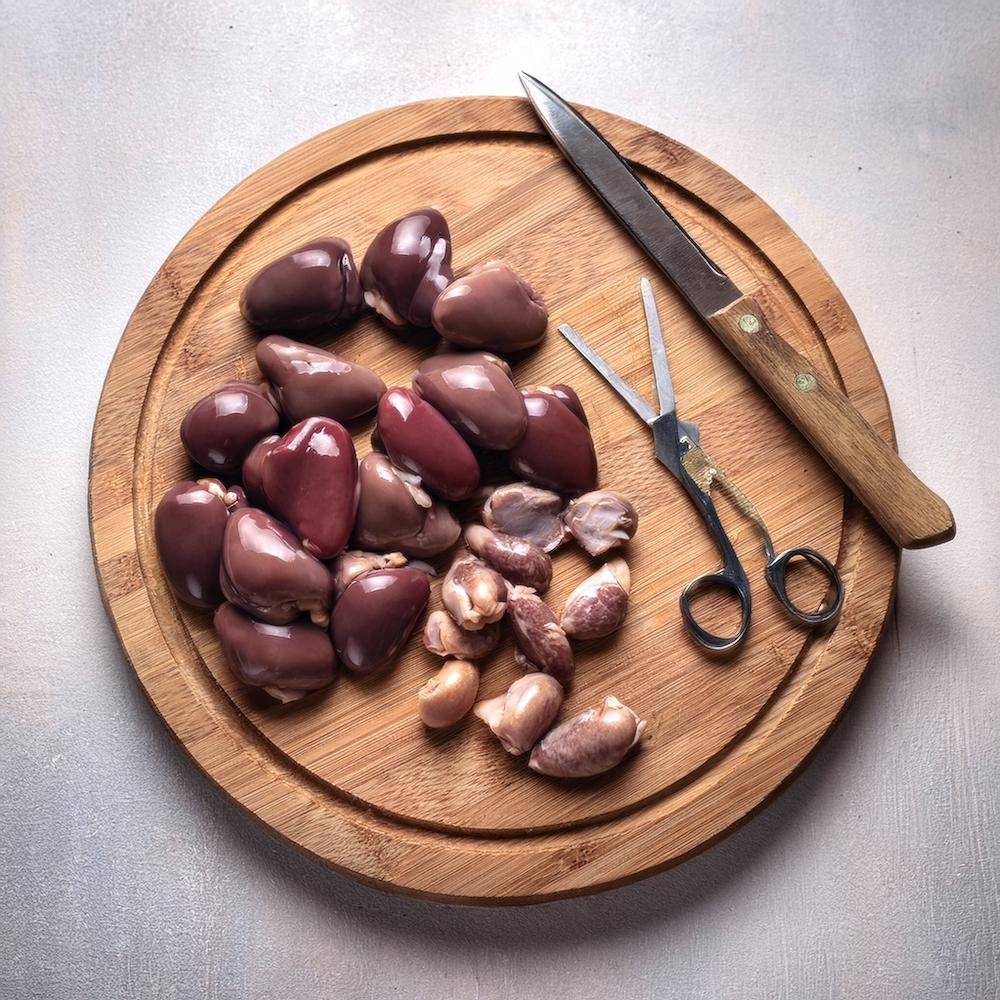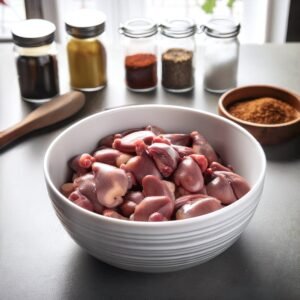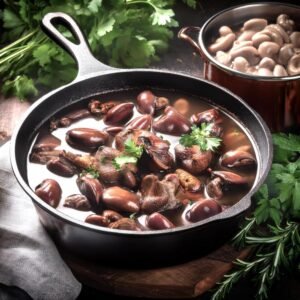Are chicken hearts gizzards? Chicken hearts and gizzards are two popular organ meats that often find their way into traditional and modern cuisines. While they’re both parts of a chicken and share some similarities, they are entirely different in terms of anatomy, flavor, texture, and cooking methods.
This article will clarify the differences between chicken hearts and gizzards, explore their unique qualities, and provide insights on how to cook and enjoy them. Whether you’re curious about which to use in your next recipe or looking to expand your culinary repertoire, understanding these two ingredients is essential.
What Are Chicken Hearts?
Chicken hearts are the actual hearts of the chicken, a small, round organ responsible for pumping blood. Despite their modest size, they pack a lot of flavor and nutrients, making them a beloved ingredient in many cuisines.
1. Anatomy and Function
- Structure: Chicken hearts are muscular organs made of smooth muscle tissue, which gives them their firm yet tender texture.
- Function: They pump blood throughout the chicken’s body, which contributes to their rich and meaty flavor.
2. Flavor and Texture
- Flavor: Chicken hearts have a mild, savory taste, often compared to dark chicken meat with a slightly gamey undertone.
- Texture: When cooked properly, they are tender with a slight chewiness that makes them satisfying to eat.
3. Culinary Uses
- Versatility: Chicken hearts can be grilled, stir-fried, roasted, or braised, making them suitable for a variety of dishes.
- Popular Dishes:
- Brazilian grilled chicken hearts on skewers (churrasco).
- Japanese yakitori hearts basted with tare sauce.
- Eastern European stews and soups featuring chicken hearts.
Pro Tip: Cooking Chicken Hearts
- Marinate chicken hearts to enhance their flavor and prevent overcooking for a juicy, tender bite.
- Cook them quickly on high heat or slow-cook them in stews for different textures.
What Are Chicken Gizzards?
Chicken gizzards are another organ meat that comes from the digestive system of a chicken. Known for their chewy texture and robust flavor, they are a popular choice in traditional dishes worldwide.
1. Anatomy and Function
- Structure: The gizzard is a muscular part of the chicken’s digestive tract. It grinds food with the help of small stones or grit that the chicken swallows.
- Function: Gizzards act like a second stomach, breaking down food into smaller particles. This muscular activity contributes to their dense, chewy texture.
2. Flavor and Texture
- Flavor: Gizzards have a deeper, more intense flavor than chicken hearts, often described as earthy and rich.
- Texture: Unlike the tender texture of chicken hearts, gizzards are firmer and require longer cooking times to become tender.
3. Culinary Uses
- Cooking Methods: Gizzards are best suited for slow-cooking techniques, such as braising, stewing, or frying after tenderizing.
- Popular Dishes:
- Southern fried chicken gizzards served with dipping sauces.
- Philippine adobo with gizzards cooked in soy sauce and vinegar.
- African pepper soups featuring gizzards as a hearty ingredient.
Pro Tip: Preparing Gizzards
- Parboil gizzards before frying or stewing to ensure they become tender and flavorful.
- Cut them into smaller pieces to reduce cooking time and make them easier to eat.
Key Differences Between Chicken Hearts and Gizzards
While chicken hearts and gizzards are often grouped together as organ meats, they differ significantly in flavor, texture, and cooking methods. Here’s a detailed comparison to help you understand what sets them apart:
1. Flavor
Chicken Hearts
- Mild, savory, and slightly gamey.
- Tastes similar to dark chicken meat, with a subtle richness that pairs well with marinades and spices.
Chicken Gizzards
- Earthy and robust with a stronger, meatier flavor.
- Their taste is more pronounced, making them ideal for dishes with bold seasoning.
2. Texture
Chicken Hearts
- Tender yet firm, with a satisfying chew.
- They cook quickly and maintain a pleasant bite when prepared correctly.
Chicken Gizzards
- Dense and chewy, requiring longer cooking times to tenderize.
- When cooked improperly, they can be tough and rubbery.
3. Cooking Methods
Chicken Hearts
- Best for Quick Cooking: Grilling, sautéing, or stir-frying.
- They can also be braised for added tenderness but do not require as much time as gizzards.
Chicken Gizzards
- Best for Slow Cooking: Braising, stewing, or frying after parboiling.
- Their tough texture benefits from low, slow cooking to break down connective tissues.
4. Nutritional Profile
| Nutrient | Chicken Hearts | Chicken Gizzards |
|---|---|---|
| Protein | High (17g per 100g) | High (20g per 100g) |
| Calories | ~130 per 100g | ~100 per 100g |
| Iron and Zinc | Rich source | Rich source |
| Cholesterol | Relatively high | Relatively high |
- Both are nutrient-dense, but gizzards are slightly leaner and higher in protein.
5. Culinary Applications
Chicken Hearts
- Versatile and quick to cook, making them ideal for grilling, skewering, or tossing into stir-fries.
- Often used in cuisines like Brazilian, Japanese, and Eastern European.
Chicken Gizzards
- Hearty and robust, perfect for slow-cooked comfort foods like stews, curries, and fried snacks.
- A staple in Southern U.S., African, and Southeast Asian cuisines.
6. Visual Appearance
Chicken Hearts
- Small, round, and reddish in color.
- Smooth and uniform in shape, resembling tiny hearts.
Chicken Gizzards
- Larger and irregular in shape, with a firmer appearance.
- Often have a pale, yellowish outer membrane that needs to be removed during cleaning.
Pro Tip: Choosing Between Hearts and Gizzards
- For Quick Meals: Opt for chicken hearts—they cook quickly and pair well with bold seasonings.
- For Hearty Dishes: Choose gizzards for stews, curries, or fried dishes where their firm texture can shine.
Popular Recipes Using Chicken Hearts and Gizzards
Both chicken hearts and gizzards are versatile ingredients that can be used in a variety of recipes. Their unique textures and flavors make them staples in traditional dishes and modern culinary creations. Here are some popular recipes featuring these organ meats:
1. Grilled Chicken Hearts (Brazilian Style)
Description
Chicken hearts are marinated, skewered, and grilled to perfection, creating a smoky and tender dish that’s a favorite at Brazilian barbecues.
Ingredients
- 1 pound chicken hearts, cleaned
- 3 tablespoons olive oil
- 2 cloves garlic, minced
- 1 teaspoon smoked paprika
- Juice of 1 lemon
Instructions
- Marinate the chicken hearts with olive oil, garlic, smoked paprika, and lemon juice for at least 30 minutes.
- Thread hearts onto skewers and grill over medium-high heat for 2–3 minutes per side.
- Serve with chimichurri sauce or lime wedges.
2. Southern Fried Chicken Gizzards
Description
Tenderized chicken gizzards are coated in seasoned flour and fried until crispy, making them a popular snack or appetizer in Southern cuisine.
Ingredients
- 1 pound chicken gizzards, cleaned and parboiled
- 1 cup buttermilk
- 1 cup flour
- 1 teaspoon paprika
- Salt and pepper to taste
Instructions
- Soak parboiled gizzards in buttermilk for 1 hour.
- Dredge gizzards in a seasoned flour mixture.
- Fry in hot oil (350°F/175°C) until golden brown, about 3–4 minutes per batch.
- Serve with hot sauce or ranch dressing.
3. Chicken Heart and Gizzard Stew
Description
A hearty and flavorful dish featuring both chicken hearts and gizzards simmered in a rich, aromatic broth.
Ingredients
- ½ pound chicken hearts, cleaned
- ½ pound chicken gizzards, cleaned and chopped
- 1 onion, diced
- 2 carrots, sliced
- 3 cloves garlic, minced
- 2 cups chicken broth
- 1 teaspoon thyme
Instructions
- Sauté onions, garlic, and carrots in a pot with olive oil.
- Add chicken hearts and gizzards, cooking until lightly browned.
- Pour in chicken broth and season with thyme, salt, and pepper.
- Simmer for 30–40 minutes until the gizzards are tender.
- Serve over rice or with crusty bread.
4. Asian-Style Stir-Fry with Hearts and Gizzards
Description
This quick stir-fry combines chicken hearts and gizzards with vegetables in a savory soy-ginger sauce.
Ingredients
- ½ pound chicken hearts, cleaned
- ½ pound chicken gizzards, sliced
- 2 tablespoons sesame oil
- 1 red bell pepper, sliced
- 1 cup snap peas
- 2 tablespoons soy sauce
- 1 teaspoon ginger, grated
Instructions
- Heat sesame oil in a wok and stir-fry chicken hearts and gizzards for 5–7 minutes.
- Add ginger, soy sauce, and vegetables, cooking for another 3–5 minutes.
- Serve hot over steamed rice or noodles.
5. Adobo with Chicken Hearts and Gizzards
Description
A Filipino classic where chicken hearts and gizzards are braised in a flavorful blend of soy sauce, vinegar, garlic, and spices.
Ingredients
- ½ pound chicken hearts, cleaned
- ½ pound chicken gizzards, cleaned and chopped
- 3 cloves garlic, minced
- ¼ cup soy sauce
- ¼ cup vinegar
- 2 bay leaves
Instructions
- Sauté garlic in a pot until fragrant.
- Add chicken hearts and gizzards, cooking until lightly browned.
- Pour in soy sauce, vinegar, and bay leaves. Simmer for 30 minutes until tender.
- Serve with steamed rice.
Pro Tip: Pairing Ideas
- Pair fried gizzards with creamy coleslaw or mashed potatoes for a Southern-style meal.
- Combine grilled chicken hearts with roasted vegetables or a fresh salad for a lighter option.
Frequently Asked Questions (FAQs)
Are chicken gizzards the same as chicken hearts?
No, chicken gizzards and chicken hearts are not the same.
Chicken Gizzards: A part of the chicken’s digestive system that grinds food, they have a dense and chewy texture.
Chicken Hearts: The heart is a muscular organ that pumps blood, offering a tender and slightly chewy texture with a mild, savory flavor.
While they’re both organ meats, they differ significantly in function, flavor, and cooking methods.
What part of the chicken are gizzards?
Gizzards are part of the chicken’s digestive system.
Location: They are located in the chicken’s abdomen, near the stomach.
Function: The gizzard grinds food using small stones or grit that the chicken swallows, helping to break down tough materials before digestion.
Structure: It’s a strong, muscular organ with a firm texture that requires tenderizing through slow cooking.
What kind of meat is chicken heart?
Chicken heart is a type of organ meat, specifically an offal.
Type of Meat: It’s considered dark meat due to its rich flavor and slightly gamey taste, similar to chicken thighs.
Texture: Tender with a slight chewiness, chicken hearts are smooth muscle tissue, unlike the striated muscle of typical cuts like breasts or thighs.
Is it healthy to eat chicken heart?
Yes, chicken hearts are highly nutritious and can be part of a healthy diet:
High in Protein: Chicken hearts provide about 17 grams of protein per 100 grams, essential for muscle growth and repair.
Rich in Micronutrients: They are an excellent source of iron, zinc, and vitamin B12, which support energy production, immunity, and overall well-being.
Low in Calories: With around 130 calories per 100 grams, chicken hearts are ideal for calorie-conscious diets.
Considerations: While nutritious, they are high in cholesterol, so they should be consumed in moderation, especially for individuals managing cholesterol levels.
Suggested Internal Links:
- What Does a Chicken Heart Taste Like?
Explains the flavor profile of chicken hearts, complementing the discussion on their distinction from gizzards. - Are Chicken Hearts Good for You?
Provides nutritional insights into chicken hearts, adding value to readers curious about their health benefits. - Do Chicken Hearts Need to Be Cleaned?
Offers practical preparation tips, enriching the article with useful culinary advice. - What Meat Goes Best with Tarragon?
Suggests complementary flavors and recipes that can pair well with chicken hearts or gizzards. - How Is Chuck Steak Best Cooked?
Adds variety for readers exploring different types of meats and their preparation techniques.
Conclusion
Chicken hearts and gizzards are both nutrient-dense organ meats that bring unique flavors and textures to the table. While they are not the same, they complement each other in culinary applications. Chicken hearts are tender, mildly gamey, and quick to cook, making them ideal for grilling or stir-frying. On the other hand, gizzards have a robust flavor and chewy texture, perfect for slow-cooked dishes like stews or fried snacks.
Both ingredients are versatile, affordable, and packed with essential nutrients like protein, iron, and vitamin B12, making them excellent choices for a healthy diet. By understanding their differences and experimenting with different cooking methods, you can elevate your meals and enjoy these underrated delicacies.
Now that you know the difference between chicken hearts and gizzards, it’s time to give both a try! Explore their unique flavors, pair them with your favorite seasonings, and share your culinary creations with friends and family.
Discover more mouthwatering recipes on our Web Site ! Stay connected and get inspired by following us on Facebook, Instagram, Pinterest, and Twitter for the latest updates!



